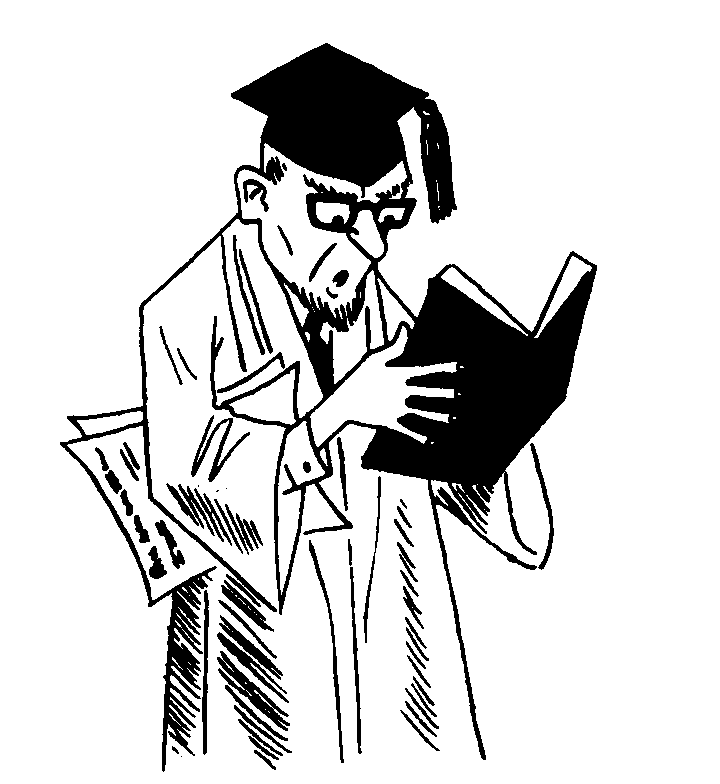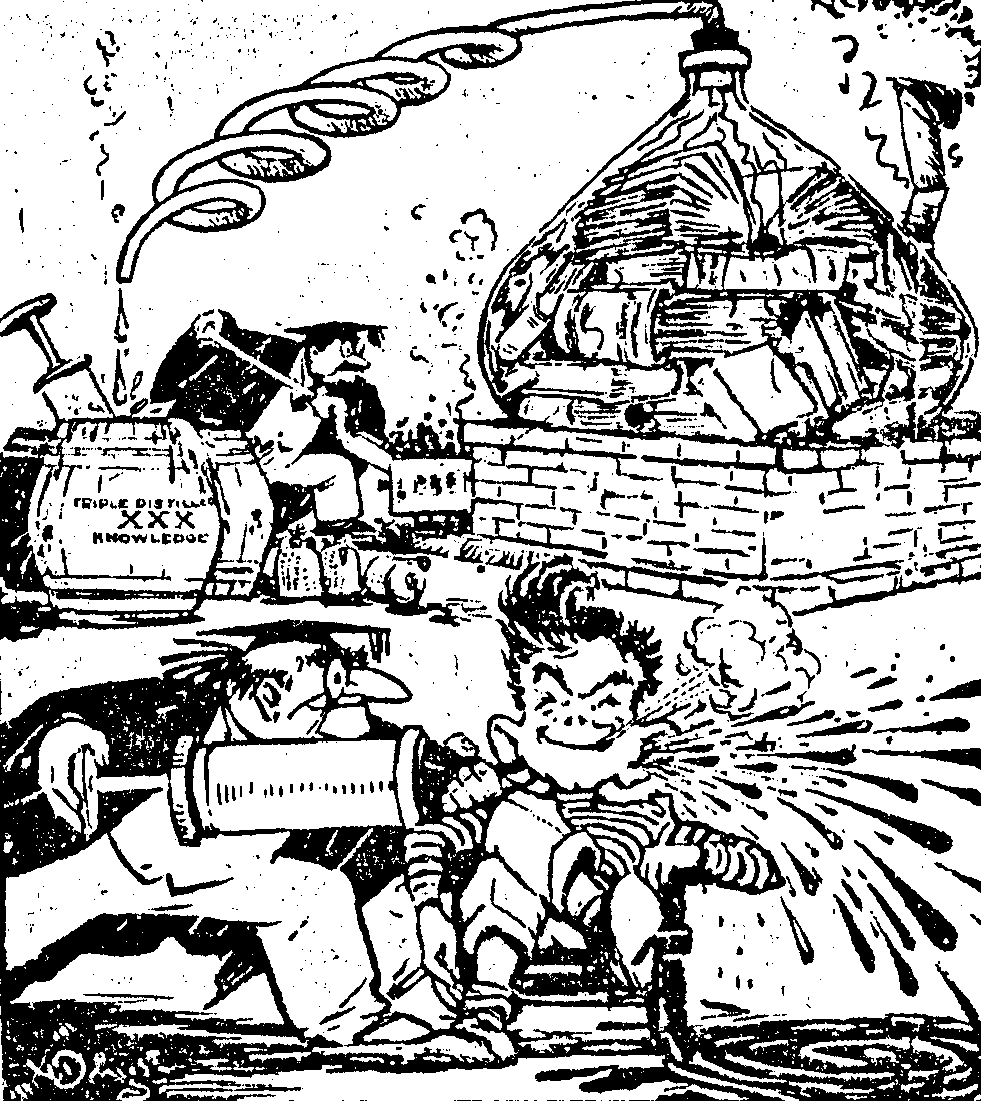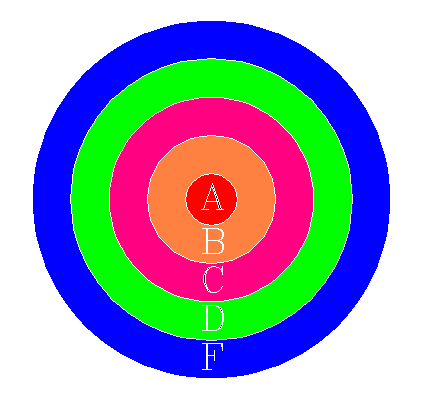HOW TO BE A SUCCESSFUL PROFESSOR WITH A MINIMUM OF EFFORT [1]
By Donald E. Simanek
 |
It is when the gods hate a man with uncommon abhorrence that they drive him into the profession of a school-master. — Seneca (c. 5 BCE - 65 CE)This article is addressed to those who aspire to becoming College or University professors, particularly in scientific fields. However, many of the principles and methods given here may be of interest to those who are already professors, for they show how to decrease your effort to a level that will match your salary. Professors in other fields, who have not yet found ways to avoid work, may, with minor modifications, apply some of these methods to their own teaching. [2]
LECTURES:
The first great timesaving method is simple: Do not waste your time preparing well-organized lectures. It is really not necessary that lectures be intelligible; it is more important that the students be impressed by your great intellect. In fact, when a lecture is unintentionally intelligible, students may dismiss it as of little importance. Besides, only naive students expect you to take time from your research to prepare lectures.
 | Modern Education. Cartoon by Ding Darling. [3] |
|---|
The function of lectures is not well defined. Superficial observation indicates that lectures are part of a complex, cyclic process: The professor selects topics at random from the course material (and some totally unrelated to the course). These are presented to the class in as complicated and devious a manner as can be devised. Students diligently transcribe as much of this as they can into their notes, and later transfer some of the notes into their minds. After a time has elapsed for memory loss, some of this is transferred back to the professor in the examinations (usually in a form bearing little resemblance to the original presentation).
This process seems to serve no useful purpose, but the fact remains that the professors are expected to present lectures whether or not they have anything important to say. Here are some suggestions for ways to fill these hours:
1) Outline the material of the text. This method is widely used. but not recommended. because it fails to impress the students.
2) Outline some other text that the students are unlikely to find. This is the more professional method.
3) Present jokes and anecdotes from your many years of experience.
Style of lecturing is important, because certain characteristics distinguish the true professor from a mere "instructor". Some of these are: absence of enthusiasm, speaking in a low voice (to the blackboard, not to the students) and mumbling words. Develop these qualities. If you have a trace of an accent, this, too, can be developed. After a few years teaching the same courses, you will probably acquire the characteristic droning, monotonous tone of voice quite naturally and with no effort.
An alternative style is that of talking fast to keep the students confused. This also discourages students from asking questions because they will be five minutes behind in taking notes and will have no opportunity to think of questions—or anything.
ATTITUDES:
 | The successful professor projects an air of superiority. |
|---|
Your attitude can have a great effect on your student's respect for your course, and on the effort they put out. The basic attitude is that students are all ignorant, but by emulating your dedication to the subject they may yet attain your great knowledge and wisdom. Other aspects of this attitude are:
1) Continually remind your students that your field of study is the only one worth pursuing, all others being trivial and undeserving of college credit. This will show that your high respect for your field.
2) Always assume that your class is the only one the students are taking. Reinforce this by giving unreasonably long assignments, and then accuse the students of laziness for not finishing them. React to your students' poor performance by asking, "What are you doing with all of your time—goofing off?" Failure to dismiss your classes on time further reinforces your attitude that no other classes exist.
3) Clearly indicate to your students that the only reason you are not covering enough material in the course is that they are too slow in comprehending it. This prevents them from blaming you because they are learning so little.
4) Keep your students striving for higher goals by reminding them of the brilliant students you have had in previous years. You may have had only two brilliant students in the last 10 years, but give the impression that you have had "a number of" such students in the past, but that now you are surrounded by small minds.
5) Get across the impression that the course material is really easy, and that if the students were only smart enough to understand the textbook you wouldn't have to waste your time lecturing to them. The brilliant student needs no instruction, and the rest are too stupid to benefit from it.
6) Give the impression that you would really rather devote your full time to research, but you are only teaching because "someone has to be dedicated enough to teach."
TECHNIQUES OF PRESENTATION:
 | "It was rejected by The Physical Review but we can always use it on the next physics exam." |
|---|
Develop the art of mathematical gymnastics. Collect from various textbooks a stock of long, "wild" derivations to present on the blackboard. This will certainly impress the students, for they measure the amount of knowledge gained from a course by the number of pages of notes they have taken.
When presenting derivations or proofs, be sure to:
1) Omit vital steps, claiming they are obvious.
2) Use completely different symbols and notation than are used in any available text. This will show that you disdain conventions.
3) Insert devious side steps, to demonstrate that the problem may be done in many ways.
4) Use mathematics not prerequisite for the course. This will greatly increase the students' knowledge as they are forced to study advanced mathematics texts to understand what you are doing.
5) Erase the blackboard soon after the material has been written down. This encourages faster notetaking. Some professors develop the art of partial erasing, so they can, from their close vantage point, see and refer to previous steps, but the students see only a smudged blackboard.
6) Always include a few mistakes in your presentations, especially ones that make the results come out wrong. This will ensure that the students study their notes after class to find where the derivation went astray. Make it clear that you are too involved in the profounder aspects of the problem to be concerned about mere "arithmetic."
7) Spend a great deal of time elaborating a derivation, being certain that the students have complete notes, then mention that there is a much simpler method.
AUDIO VISUAL AIDS:
The preparation of lectures is a tedious and time-consuming task. Fortunately there is a way out of this, a way that is in fact encouraged by most administrations: the use of videos. A large number of videos are available that effectively take the place of the classroom instructor.
It is true that most of these have rather low educational value, but remember that education is not their purpose. Most videos are designed with one or more of the following purposes in mind:
1) To make money for the producer.
2) To entertain the students.
3) To consume class time.
4) To give the impression that modern teaching methods are being used.
Do not pass up those videos that really do teach something; there are so few of these that you must still pad out the course with the others.
Many graduate theses and surveys by film producers have shown conclusively that videos are one of the most effective teaching methods. This is because they usually present so little information that even a half-awake student can absorb it. This is certainly more efficient than the old-fashioned method of trying to force into a student more knowledge than he was willing to learn.
Another value of videos is that students like them. This helps create a desirable psychological attitude toward the course. Some reasons for the popularity of films are:
1) Some students benefit from the sleep they get during videos.
2) Dull students are entertained by them.
3) Bright students find most videos so lame as to be laughable, and are likewise entertained.
4) Some students are hypnotized by videos (a carry over from adolescent TV watching). This makes class time pass by painlessly.
DEMONSTRATIONS:
Lecture demonstrations are popular in physics courses, not because of their educational value, but because they keep students awake and entertained, ensuring that they will enjoy the course. In schools where a professor's worth is measured by popularity, one should not overlook the value of lecture demonstrations, even if they do involve some amount of work. Lecture demonstrations are not without danger, for they necessarily involve large and often lethal equipment. One well-known professor ended his career as he became a current path between a defective x-ray machine and a puddle of water he had spilled earlier. Another fell down an elevator shaft while adjusting a Foucault pendulum. [4] An extremely unfortunate case occurred when professor X was demonstrating angular momentum. He had placed his rotating platform on top of the lecture table so the students could see better. As he sat on the rotating platform, a decrease in his moment of inertia produced an increase in angular velocity, resulting in unstable equilibrium. The inelastic impact when he hit the floor broke his arm. These moments will long be remembered by the students who witnessed them, even after the physics is forgotten! Do not underestimate the power of demonstrations.
CLASS ORGANIZATION:
Never dismiss classes on time. Your course is more important than anyone else's. Genius cannot be tied to a schedule.
By all means, set up office hours and invite students to come to you with their problems. This will impress students with your genuine interest in them. You can easily plan to be unavailable during your office hours.
It is essential that a professor attend meetings and conventions, and this will necessitate missing classes. The inexperienced professor might simply dismiss classes at these times, but it is obvious that this would be depriving students of valuable class time for which they are paying. It is much better to find a substitute lecturer. Be careful not to choose someone who knows more about the course than you do, since this might confuse students and be harmful to their attitude toward you. As an alternative, find someone to administer an exam during your absence, or assign a long essay or problem assignment.
EXAMS:
 | Ingenious exams can perplex even the best students. |
|---|
Much has been written about the relative merits of the various kinds of exams, but in fact it doesn't really matter what kind you use, for any exam serves the primary function of intimidating the students and frightening them into studying. If you have a slave-labor corps (i.e. assistant graders) choose any kind, even problem or essay exams. But if you are forced to read and score them yourself it is best to stick to objective exams, preferably machine graded. Eventually you will learn that no exam yet devised is a good measure of a student's knowledge; and ever if the perfect exam did exist, professors would find some excuse not to use it.
The function of an exam is not to find out how much the student knows, but to show the students how little they know. This will spur them to greater effort. Also, it is generally true that students exercise their brains more intensively while taking an exam than at any other time during the course, and this is certainly valuable practice for them.
The exam should therefore be constructed to challenge the student and make him think. It is not so important what questions you ask, but how you ask them. Even a trivial question can be disguised by proper wording so that it becomes a challenge. In fact, if a genuinely simple question is included on the exam most students will assume it is a trick question and miss it anyway.
Students often come to a test half-asleep because they were studying all night. One way to wake them up is to make the first question on the exam a real shocker, such as:
 | A useful dartboard for assiging grades. |
|---|
1. Which one of the following is not an answer to this question?
a) All of the responses below.Actually, this sample question contains useful elements that many professors prefer to scatter at random throughout an entire multiple-choice exam, to keep the students awake.
b) This one.
c) Some of the above.
d) All of the above.
e) None of these.
Shrewd test scheduling can add amusement to your life. Choose exam dates that conflict with as many school activities as possible. This discourages students from wasting time on extracurricular activities. Many professors take delight in agreeing in advance to schedule all of their exams on the same day. Don't return tests promptly; let them lie on your desk several weeks or a month. This will give the students the impression that you took time to evaluate them very carefully.
ASSIGNMENTS:
Assign homework problems, the more the better. You need not look at these; that is what assistant graders are for. Working these problems may be the only way that students will learn anything from your course. Also, frequent assignments of outside reading (especially obscure texts in foreign languages) will show that you have a broad knowledge of the literature of your field. This also gives the students good practice in library search techniques, as they look in vain for a reference, then discover the only available copy is in your office.
EVALUATION OF LAB REPORTS AND ESSAYS:
Many students will overlook low grades on homework problems, feeling that they won't count for much, but they will fight zealously for an extra point on a lab report. They may realize that lab reports must be graded somewhat subjectively, and there is always room for argument.
Some instructors simply give each paper a score, but write no comments on it (they actually don't read the papers). This is not recommended, for students will complain, "Why didn't I get an A? There aren't any corrections on my paper." This can be avoided, even without going to the unnecessary work of reading the papers. Use red ink liberally, at random, even in places where there is nothing particularly wrong. Comments that may be used indiscriminately are:
 | Use red ink liberally. |
|---|
1) Vague.etc.
2) You could elaborate on this.
3) Too brief.
4) Do you really understand this?
Very seldom will a student be able to argue these statements. Your students will be satisfied that you read their paper thoroughly, but will not take the time to read the comments to see whether they are relevant.
GRADING:
The first rule is: Don't give A's. A student who gets an A is apt to become lazy and shirk studying; lower grades will spur him to greater effort. The first exam of the semester is an exception to this rule. If you grade it too harshly, many students may drop your course. They may be under the delusion that their other courses are more important than yours. If they drop out, they will be deprived of the benefits of your course. Therefore it is better to grade the first exam leniently. Then, when it is too late to drop the course, mention that the first exam was worth only 5% of the grade, and proceed to give tougher exams in which you give nothing above a C. An alternative is to give the first exam late in the semester, and make it a tough one.
 |
| Being "normal" is a mean accomplishment. |
|---|
Many educators worship the "normal distribution", and its offspring, the "curve". But for physics courses a more suitable curve for the final grades is a decreasing exponential curve. (Some professors prefer a hyperbolic curve, but this is a matter of taste.) Even the decreasing linear "curve" (shown at the right) may be chosen. The use of these curves will ensure your reputation on campus. Students will soon realize that you have high standards and that your course is no "snap course".
CHOOSING A TEXTBOOK:
There are several schools of thought on textbook choice. If you have written a textbook yourself, by all means use it, regardless of its merit, for that may be the only way to earn royalties. If you have not written a text, any one of the following approaches may be used:
1) Choose a text at random, then proceed to ignore it completely during the course on the grounds that
a) you don't like its notation or terminology.2) If you follow the text at all, cover the chapters in random order (example: 21, 2, 5, 19, 1, etc.) This will demonstrate that you have an original approach to the subject.
b) a good text for the course hasn't been written.
3) Some prefer to use no textbook. This gives you complete freedom, for students are not likely to refer to library texts to check your presentation.
WRITING YOUR OWN TEXT:
 | The student mind is like a blotter. It soaks it in but gets it backwards. |
|---|
Don't hesitate to try your hand at writing a textbook. It isn't really difficult, and can add a great deal to your reputation and possibly to your income. The large number of worthless texts already on the market proves that no talent need be required of an author.
The procedure is simple. Find a textbook you like, and use its table of contents. Then from other textbooks on the same subject gather up ideas, diagrams, tables and text fragments, put them all together to disguise their origins, and you have a textbook! If you want problems at the ends of chapters, collect those in the same way. Change the numerical values and the wording, assign them to your students, and collect the answers that you will need to include in the book. Of course, some of the answers may be wrong, but this is of no concern. Students will learn to rely more on their own judgment when they have worked a problem ten different ways and then discover that the book's answer was incorrect.
Do not make the text easily understandable, for that would give it the air of a "popularization". A textbook must be intricately worded, remote and impersonal, to rank as a serious scientific text. The student must come to the book, not vice versa; and the more effort required for this, the more the student will learn. Fashions do change in textbooks. There was a time when the ideal textbook had very few diagrams, no photographs, no headings or subheadings, and, ideally, no index. That was the sort of book the student had to work to understand—no spoonfeeding then! Many of these books are still in use in advanced courses. But today the stress is on appearance, especially in freshman texts. A book is judged by how well it looks and feels as one flips through the pages. Many publishers have found that the sales of a book can be boosted simply by bringing out a new edition (boldly announced on the dust jacket: NEW REVISED EDITION) with diagrams in color, larger color photographs, bold type headings, and 50% of each page in blank margins. This revamping usually requires no change in the text material.
Two elementary physics texts may be written with little more effort than writing one. First write a text using calculus. Then go through it and change all of the "d's" to Δ's, and the integrals to summations and you have a non-calculus text—doubling the potential sales, and giving you two books to your credit if you use different titles. This is worth considering if you are at a "publish or perish" institution.
The title of a book is important. The rule is that the title must give no clue to the actual level of difficulty of the book. Thus graduate level texts are entitled "Introduction to ... " or "Fundamentals of, or "Elements of ...". These books invariably assume that the reader has been introduced to the fundamentals in some earlier course. Books in newly developed areas that have not yet achieved a satisfactory structure of laws would be titled "Theory of ...".
Another example of this "rule of the misleading title" is the title "Handbook of ...", which will generally be a book so heavy it will strain your arm to carry it. The Germans started this with the "Handbuch der Physik", 54 huge volumes!
THE REWARDS OF TEACHING:
Being a professor is not without its drawbacks. The nature of the position demands respectability, thereby denying one many of the usual forms of recreation. What then, are the joys and rewards of the work?
Some of the pleasure is subtle, such as the delight in managing to publicly demolish a colleague's theory; the satisfaction of flunking all of the athletes in your class; the sense of accomplishment when 30% of your students drop your course. But these are the small pleasures; the major reward is the opportunity to do research.
RESEARCH:
It has been said that "physicists are just grown-up boys who like to play with toys, only their toys are bigger, more expensive, and often more lethal, than anyone else's." Fortunately, through generous government and foundation grants, scientists are able to purchase the neatest toys imaginable. Research grants have some strings attached, but there are still ways to use them to buy permanent equipment, provide pay for student labor to do all of the work, produce enough productive results to satisfy the granting agency, and still have enough money left over and equipment available to do the research you really wanted to do all along. The advantage of doing research in a University setting is that the actual labor of the work can be left to graduate student assistants, while the you devote your much more valuable time to publishing the results and bearing the burden of the fame this brings.
Eager and hard working graduate students may be expected to carry out the entire research program, and supply the genius to keep it going. They will be content with the honor of being listed as co-authors, or even a footnote, when you publish their results. There is a problem that such valuable students may soon receive their PhD's and leave the school, necessitating the time-consuming training of replacements. But there are ways to lengthen the stay of your best students. Keep then so busy with research work that they haven't time to take many courses. Arrange research expeditions to remote locations, keeping them out of school for months at a time. Give them low marks on their comprehensive exams, forcing them to stay another year to take them over. Finally, require several revisions on their theses, which may delay them two or three years more, thus extending their useful life on your research team.
Your success as a researcher will be judged not on the value of what you do, but on the number of papers you publish and the number of citations they generate. Remember, even flawed research papers are cited by those who notice and correct the flaws. The instructions above should provide plenty of papers, but something should be said about the type of research to choose. Here are some guiding principles.
1) It is best to work in one of the currently popular areas of research; this will automatically ensure that your work will be considered important.
2) If you do not work in one of the "fad" areas, make sure your project is a large and expensive one, giving the impression that you are about to make an important breakthrough in a new field.
3) Choose a project that will give many publishable results in preference to one that would give only one paper, even if that one paper were of great importance. The guiding principle is, "It is not the importance of the results, but their quantity that determines your stature." Besides, who can tell in advance which results will ultimately be important?
4) If you are just getting started in research, choose a project that will give immediate results rather than a long-range project.
5) If you work at a small college, the choice of project will depend only on the available funds. Any research project will be sufficient to impress the administration, for they will know nothing about what you are doing and will be overjoyed that some sort of research is being done.
6) If you really don't know what you are doing, choose a subject so obscure that no one will read your published papers. This ensures that your results will go unchallenged.
FORMAL TRAINING:
The advice given in this paper is based on the experience of many successful professors, and should be sufficient for most readers. However new methods are continually being discovered. Teacher's colleges and the education schools of our large universities are in the forefront of this research, continually developing new techniques that enable people with no knowledge or talent to be teachers. Some of these methods are taught openly, but others, not yet acceptable enough for inclusion in "methods" texts, are taught only by example. The student who aspires to become a professor would be well advised to take a course or two in "education". [5] One can learn much by observing how these classes are taught. For example, how the "class discussion method" can free the professor from the tedium of preparing lectures. The "discovery method" eliminates the work of advance planning. Class "projects" (i.e. busy work) can fritter away class time and oral student reports can consume the rest of the time. These methods leave little for the professor to do but attend class regularly, give assignments and exams, and now and then raise questions that have no definite answers.
The average student in such a course spends much time complaining of its trivia, but the perceptive student will observe and take notes on techniques that can be used to advantage in a future career.
April 4, 1968
ENDNOTES
[1] A shorter version of this article originally appeared in Fusion magazine, May, 1958. It was written while the author was a student at the University of Iowa, and acknowledgement is hereby given to those professors who served as inspiration for this paper. This version [April, 2019] has been lightly edited and somewhat brought up to date. For example, "films" has been replaced by "videos", and a few sentences edited using gender-neutral language
[2] More general advice, applicable to other disciplines, will be found in "Practical Principles for the New Professor", by R. A. Preston in AAUP Bulletin, Autumn, 1966.
[3] Cartoon by Ding Darling, editorial cartoonist for the Des Moines Register and an alumnus of the State University of Iowa. One of several panels, on aluminum, chronicling the history of books. These panels were mounted above the entrance of the main university library in the 1950s. Later they were removed for display inside the library, to prevent damage by weather. This panel shows professors triple distilling books containing the knowledge of mankind, and injecting it into the mind of a smug student.
[4] An alert student timed his fall, obtaining a good experimental value for the acceleration due to gravity.
[5] More than two such courses would merely be repetition of content, of little value, except possibly as "snap" courses to raise one's grade point average.
Return to Donald Simanek's home page.
Return to the humor and satire page.
Return to the education page.